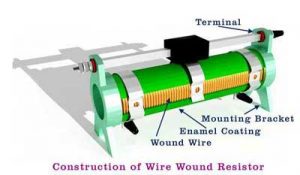Construction of wire wound resistor
The construction of a wire wound resistor is shown in above figure. It uses a resistance wire, such as nichrome. The wire wound resistor is manufactured by winding a length of resistive wire such as nichrome on to a round, hollow porcelain or ceramic core. The ends of the winding are attached to metal terminals inserted in the core. The tinned copper wire leads are attached to these metal pieces. This assembly is coated with enamel containing powdered glass. It is then heated to develop a coating known as vitreous enamel. The cement or varnish can be used as a coating. This coating is very smooth and gives mechanical protection to the winding. It also helps in conducting heat away from the unit quickly. In other wire wound resistors, a ceramic material is used for the inner core and the outer coating. Some of the wire wound resistors are too heavy to be suspended by wire leads and therefore, must be mounted with bracket.



